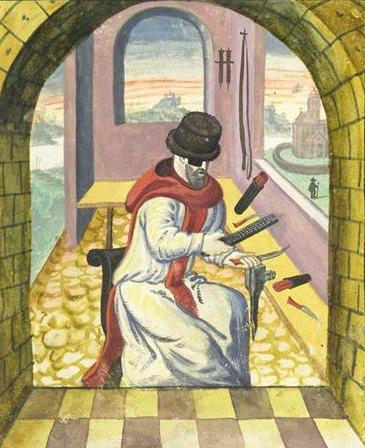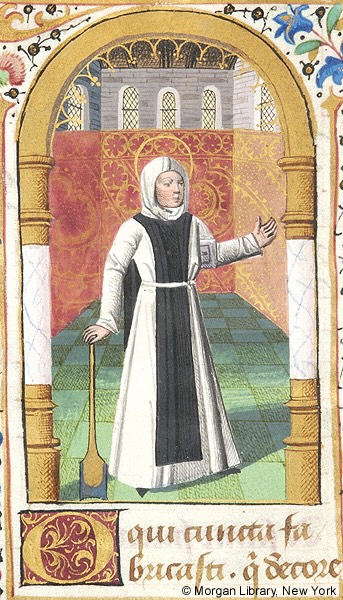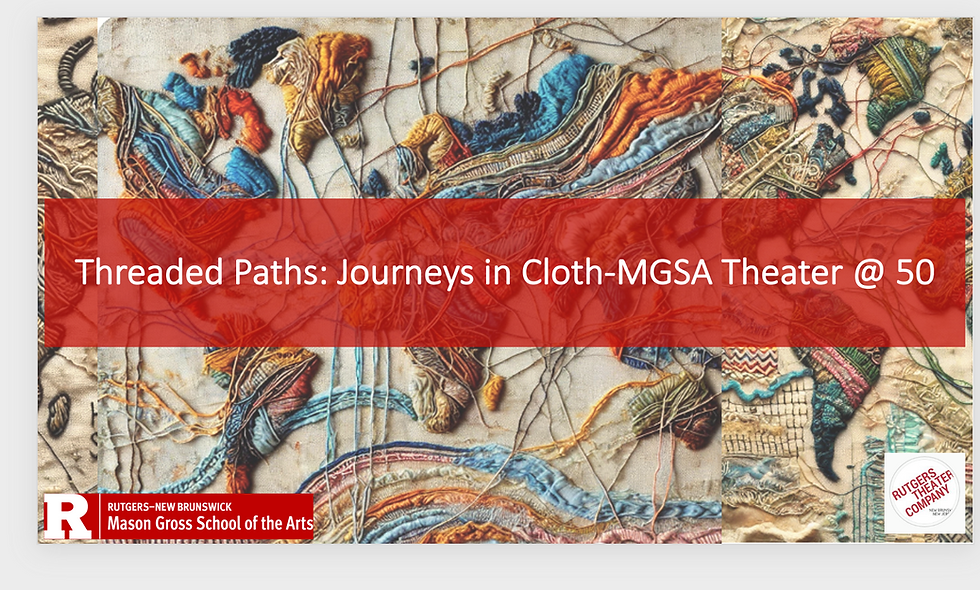Workers, Warriors, and Worshippers: The Tabard as a Symbol of Alliance, Allegiance, and Identity (Part 1 of 3)
- vmramshur
- Mar 14
- 5 min read
Updated: Mar 15
As you know, I run a costume design program at a major American university. Within our costume studios and workshops, and a long-standing joke among students and staff persists: “Val loves a tabard” - It's TRUE!
Production photos from Life is a Dream , 2023 And Allegory of Land, Air and Water, 2021
It started as a practical, budget-friendly way to facilitate quick onstage transformations—what other garment allows a character to transition seamlessly from worker to warrior to worshipper with just two simple rectangles of fabric? Beyond its utilitarian function, the tabard also challenges and redefines hierarchy, class, and identity, making it one of history’s most adaptable garments.
Over the years, I’ve employed the “tabard solution” in multiple theatrical productions and artistic projects, and I’ve even (half-seriously) entertained the idea of launching a fashion line inspired by its form. Despite its ostensibly simple construction, this garment, often associated with Renaissance fairs, historical reenactments, and medieval-themed films, possesses a rich and complex history. I’ve previously explored personal heraldry and its contemporary equivalents, but now it’s time to dig deeper into the long and fascinating story of the tabard.
The Tabard in Context: A Historical Overview
The tabard is one of the most recognizable garments of the medieval period, yet its significance extends beyond mere fashion. Defined by its sleeveless or short-sleeved structure, often worn over armor or daily attire, the tabard functioned as a symbol of identity, allegiance, and societal role. From battlefields to guild halls to religious institutions, this deceptively simple garment served workers, warriors, and worshippers alike. To fully appreciate the tabard, one must understand a world in which clothing was not merely decorative but communicative.
Origins and Evolution
The origins of the tabard date back to the early medieval period, when its primary function was one of practicality. Initially conceived as a tunic-like garment, it was worn by laborers to facilitate ease of movement and provide a layer of protection. However, by the 12th and 13th centuries, the tabard had evolved into a defining element of military and social dress.

Knights wore heraldic tabards over their armor, emblazoned with their coats of arms to ensure battlefield recognition. In an era where distinguishing friend from foe was crucial, this visual system of allegiance was not merely ornamental but essential for survival.
Beyond warfare, the tabard held significance in other spheres of medieval life. Heralds—who functioned as messengers, diplomats, and record-keepers—wore elaborately decorated tabards displaying the insignia of the lords they served. These garments not only conferred legitimacy upon the heralds but also ensured safe passage, even across enemy lines. It is believed that heralds may have initially worn secondhand tabards gifted by their lords as a mark of favor, signifying their special relationship. Wearing a lord’s armorial tabard was more than a uniform; it was a visible declaration of trust, protection, and authority, effectively allowing the herald to speak with his master’s voice. Because of this association, the knights’ tabard, as depicted in medieval manuscripts, often appears nearly identical to that of a herald.

In ecclesiastical settings, members of certain monastic orders and church officials incorporated tabards into their vestments, their use signifying status and devotion within the sacred hierarchy.
The Symbolism of the Sideless Garment
One of the most compelling aspects of the tabard is its sideless construction, which served both practical and symbolic functions. Personally, I have always been drawn to the simplicity of rectangular garments—perhaps because, for a long time, that was all I could sew! Just ask my graduate school draping professor.-you know who you are.
The tabard’s open sides allowed for the prominent display of heraldic emblems, transforming it into a highly effective means of visual communication. In a world where literacy was limited, textiles conveyed messages of allegiance and identity without the need for words.

Identity & Function

For knights, the tabard was as vital as their armor. As full suits of plate obscured individual warriors, the tabard became a crucial marker of lineage and loyalty. It fostered a sense of immediate alliance—wearing a tabard signified belonging to a kingdom, a noble house, or a brotherhood of warriors. Additionally, it served a functional purpose, protecting armor from exposure to the elements and prolonging its durability.
Beyond the battlefield, the tabard was embraced by guild workers and artisans, often functioning as a type of apron adorned with trade symbols. In bustling medieval towns, where literacy remained the exception rather than the norm, these garments operated as mobile signifiers of profession and social standing. A cobbler, a blacksmith, or a baker could be identified at a glance, reinforcing the garment’s integral role in shaping medieval occupational identity.
A Cutler, A Lantern Maker, A Chainmail Maker and Fabric Dyer- from the The House Books of the Nuremberg Twelve Brothers Foundations, wearing a "tabard apron" under a cowl Germany, 16th c.
left: black scapular worn in the Order of Cistercians as early as the 13thc, Right: Dominican Brothers seen wearing white scapulars in San Francisco, 2025
Religious institutions also employed the tabard, worn by altar servers and those fulfilling specific duties within the church. In this context, the garment symbolized devotion and humility, its donning signifying both practical function and spiritual commitment. Over time, the tabard along with other garments influenced the evolution of several early Christian ecclesiastical vestments, including the scapular ( Initially,serving as an apron to protect the monastic habit during labor.) and the chasuble ( derived from Roman paenula, a semicircular or full-circle cloak worn in ancient Rome as a practical outer garment dangerously close to a tabard... sort o) by the 17th c the fiddleback chausble resembles a tabard in many ways.
17th c Fiddleback chausable of Father Junipero Serra, housed at Mission Carmel, CA
The Tabard’s Enduring Legacy
The tabard was never merely a garment; it was a declaration. It communicated allegiance, profession, and purpose in an era when visual identity was paramount. Its sideless design, with its clarity and openness, rendered it uniquely suited to conveying belonging and affiliation.

Even in contemporary society, the legacy of the tabard persists. Its echoes can be seen in modern uniforms, ceremonial dress, and branding. Whether in the insignia on work attire, the logos on sports jerseys, or the regalia worn by officials, the concept of clothing as a marker of identity and allegiance remains deeply ingrained in our visual culture. While the medieval tabard may now be an artifact of history, its influence continues to shape how we signify affiliation and status through dress. We will look at more in contemporary culture in part 3.
Coming Up in Parts 2 and 3
In Part 2: Tabard Adjacent, we will explore sideless garments across different cultures and examine their practical, social, and ceremonial significance.
In Part 3, we will analyze the tabard’s influence on contemporary dress, historical reenactment, and visual symbolism, considering why it continues to captivate historians, artists, and fashion enthusiasts alike.
See you next time
- Val
Sources
Scott, Margaret. Fashion in the Middle Ages. Getty Publications, 2011.
Piponnier, Françoise & Perrine Mane. Dress in the Middle Ages. Yale University Press, 1997.
Cumming, Valerie, C.W. Cunnington & P.E. Cunnington. The Dictionary of Fashion History. Bloomsbury, 2010.
Newton, Stella Mary. Fashion in the Age of the Black Prince: A Study of the Years 1340-1365. Boydell Press, 1999.
Heraldry Society. An Introduction to Heraldry. Heraldry Society Publications, 2015.
Hausbücher der Nürnberger Zwölfbrüderstiftungen" (Housebooks of Nuremberg or The Twelve Brethren Books, Stadtbibliothek im Bildungscampus Nürnberg Germanische Nationalmuseum as
Book of Hours, Morgan Library































Love these blogs. They fascinating and informative. thank you!